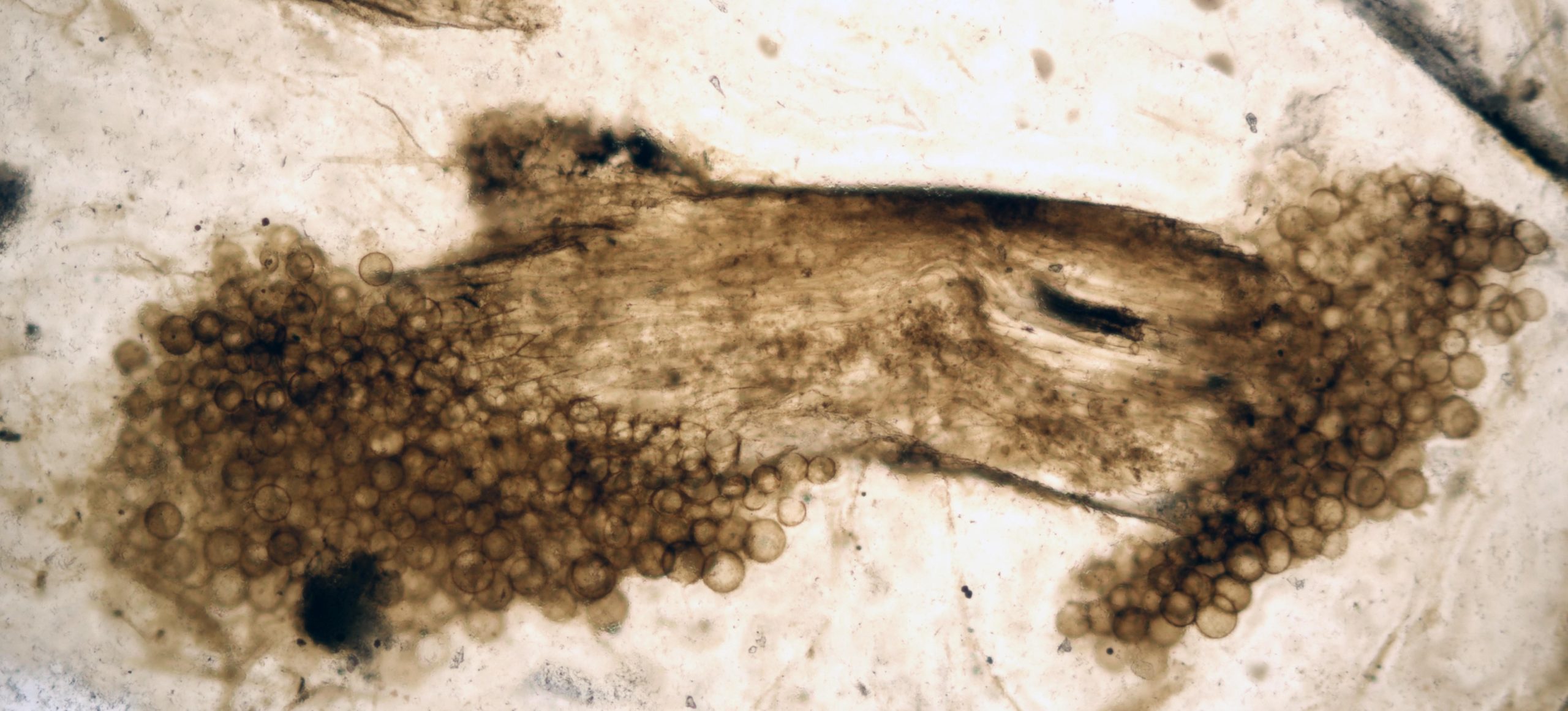Um pequeno pedaço da planta fóssil de Rhine com fungos fósseis colonizando os membros, visto através de um microscópio. Crédito: Loron et al.
A tecnologia de ponta revelou novos insights sobre um tesouro fóssil mundialmente famoso, que pode fornecer pistas importantes sobre o início da vida na Terra.
Cientistas que investigam o esconderijo de fósseis de 400 milhões de anos, desenterrados na remota região nordeste da Escócia, relatam que seus resultados mostram um nível mais alto de preservação molecular nesses fósseis do que o esperado anteriormente.
Um novo exame do tesouro primorosamente preservado de Aberdeenshire permitiu aos cientistas identificar as impressões digitais químicas dos vários organismos dentro dele.
Assim como a Pedra de Roseta ajudou os egiptólogos a traduzir os hieróglifos, a equipe espera que esses símbolos alquímicos ajudem a entender mais sobre a identidade das formas de vida, que são representadas por outros fósseis mais obscuros.
Mineralizado e revestido com rocha dura composta de sílica, o impressionante ecossistema fóssil foi descoberto perto da vila de Rhynie, em Aberdeenshire, em 1912. Conhecido como Rhynie chert, é originário do início do período Devoniano – cerca de 407 milhões de anos atrás – e tem um papel importante na compreensão dos cientistas sobre a vida na Terra.
Os pesquisadores combinaram o que há de mais moderno em imagens não destrutivas, análise de dados e[{” attribute=””>machine learning to analyze fossils from collections held by National Museums Scotland and the Universities of Aberdeen and Oxford. Scientists from the University of Edinburgh were able to probe deeper than has previously been possible, which they say could reveal new insights about less well-preserved samples.
Employing a technique known as FTIR spectroscopy – in which infrared light is used to collect high-resolution data – researchers found impressive preservation of molecular information within the cells, tissues, and organisms in the rock.
Since they already knew which organisms most of the fossils represented, the team was able to discover molecular fingerprints that reliably discriminate between fungi, bacteria, and other groups.
These fingerprints were then used to identify some of the more mysterious members of the Rhynie ecosystem, including two specimens of an enigmatic tubular “nematophyte”.
These strange organisms, which are found in Devonian – and later Silurian – sediments have both algal and fungal characteristics and were previously hard to place in either category. The new findings indicate that they were unlikely to have been either lichens or fungi.
Dr. Sean McMahon, Chancellor’s Fellow from the University of Edinburgh’s School of Physics and Astronomy and School of GeoSciences, said: “We have shown how a quick, non-invasive method can be used to discriminate between different lifeforms, and this opens a unique window on the diversity of early life on Earth.”
The team fed their data into a machine learning algorithm that was able to classify the different organisms, providing the potential for sorting other datasets from other fossil-bearing rocks.
The study, published in Nature Communications, was funded by The Royal Society, Wallonia–Brussels International, and the National Council of Science and Technology of Mexico.
Dr Corentin Loron, Royal Society Newton International Fellow from the University of Edinburgh’s School of Physics and Astronomy said the study shows the value of bridging paleontology with physics and chemistry to create new insights into early life.
“Our work highlights the unique scientific importance of some of Scotland’s spectacular natural heritage and provides us with a tool for studying life in trickier, more ambiguous remnants,” Dr. Loron said.
Dr. Nick Fraser, Keeper of Natural Sciences at National Museums Scotland, believes the value of museum collections for understanding our world should never be underestimated.
He said: “The continued development of analytical techniques provides new avenues to explore the past. Our new study provides one more way of peering ever deeper into the fossil record.”
Reference: “Molecular fingerprints resolve affinities of Rhynie chert organic fossils” by C. C. Loron, E. Rodriguez Dzul, P. J. Orr, A. V. Gromov, N. C. Fraser and S. McMahon, 13 March 2023, Nature Communications.
DOI: 10.1038/s41467-023-37047-1

“Criador. Viciado em mídia social que gosta de hipster. Fã da web. Fanático por álcool apaixonado.”






More Stories
‘Isso me deu arrepios’: a explosão de raios gama mais poderosa já observada escondia um segredo, dizem os cientistas
Vacina contra herpes oferece esperança contra a demência
Gripe Teflon aumenta nos Estados Unidos; Sintomas, práticas e avisos ao cozinhar em panelas antiaderentes